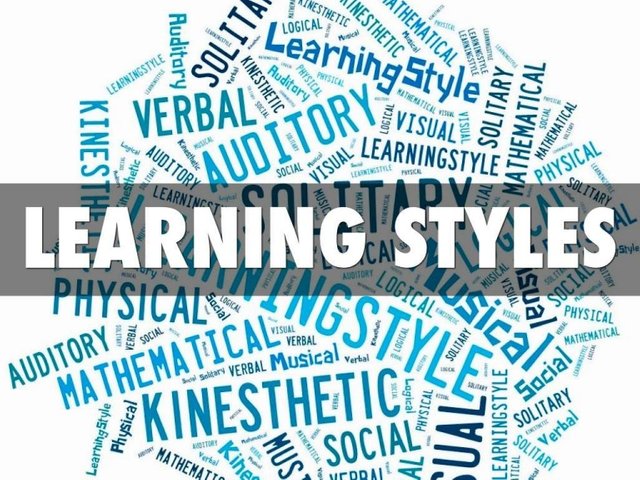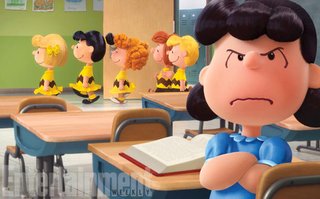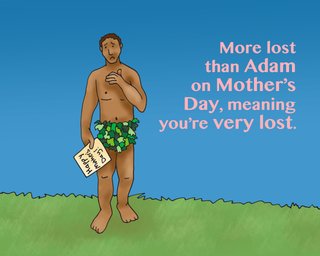LEARNING STYLES: Know yourself a little more

Source
In this opportunity I will talk about the different learning styles according to the classification that the Neuro Linguistic Programming (NLP) does, with the intention that you identify yours and you can achieve a significant learning, as I mentioned in the post: The experience of Learning: How do you think it happens and how it really happens?
But.... I think it is important that we first focus on the definition of "Learning Styles" of Wikipedia for allows us to better understand today's topic:
Learning styles are defined as the different ways in which an individual can learn:
1.- For D. E. Hunt, the learning styles describe the conditions under which a student is in the best situation to learn, or what structure he needs to improve the learning process.
2 .- In general terms, learning styles are used in the psychological and educational field to refer to the distinctive way in which people solve problems, that is, the response to stimuli and information.Source.
Understanding this concept, we see that human beings do not have a unique learning style and depending on our individual characteristics we tend to have predominance or inclination for one style over the other, which is why it is well worth knowing what is the style of learning that we have consciously or inconsciously applied throughout our lives, enhance it (if we have obtained good results with it), change it (if we have not found our particular style) and ..... why not? identify the style of learning of our friends to obtain an "Assertive Communication".
Learning styles according to P.N.L
Before knowing the different learning styles, it is important to point out that:
*Human beings "We select and represent" what we learn in different ways.
*Each of us is able to use more than one learning style.
*We can activate any of the 3 styles presented below:
VISUAL Representation System
As we indicated earlier, human beings "represent" what we learn in different ways, that is why there are people who remember data, images, numbers and information by reconstructing them in their minds in a "visual" way. This class of people usually perform the following types of practices:
1.- They need to take their own notes.
2.- They like to explain in a graphic, written and illustrative way.
3.- They prefer to study by reading a book, observing slides, videos, documentaries, as well as obtaining the teacher's explanation on the blackboard.
4.- Their learning is more productive when they observe.
The visual people, have a high level of energy, are restless and observant, they capture the detail and many of the small aspects that other people no. They usually visualize images in their mind to be able to remember them, and it is common that to do it, small notes must be written.....and They need quiet places to concentrate. Source
AUDITIVE Representation System
People with hearing predominance are easily recognized because they need to express themselves verbally and at the same time they need to obtain the information in the same way "listening", for this reason they usually:
1.- Understand only with the "verbal" explanation of others.
2.- They do not need to take notes.
3.- Read aloud (because they need to be heard).
4.- They show more interest when they are spoken to.
According to the NLP, they are more relaxed, communicative and with great expression skills, they like to talk and remember in great detail each of the words they have heard. Source
Representation System kinesthetic
Even though the systems of visual and auditory representation are the most common, there is also kinesthesia, that is to say, that way of learning where several senses are conjugated: touch, smell and taste, surprisingly not?, usually this type of people :
1.- They remember aromas, flavors, smells.
2.- They are motivated by the physical contact with others (a handshake, a pat on the back, a hug).
3.- They usually have the ability to do things with their hands, to build, to design, among others.
Kinesthetic people have no special interest in the details, but yes, they are more spontaneous and tend to seek emotions in the persons. Source
Now!, how are we used to learning and how do we like to do it?
Most educational systems have adapted practices where the individual can use the systems of auditory and visual representation, the serious error then is to arrive to the classroom and teach without having certainty of the predominance of students.
For this reason we remember with frustration the boring and endless explanations of those professors who did not stop talking in the classroom.

Source
and that after a few minutes you only hear the voice of the teacher of Charlie Brown ..... I assure you that if you are a "visual" student you will have the same face as Lucy.
think that communication should only exist between him and the classroom blackboard, so they fill with endless letters, symbols, numbers and scribbles that you do not know where they start and where they end up

Source
... imagine just a moment what would be the result of an auditory student in this tangle of notes.
...... And not to mention the kinesthetic, those who are not good at listening or watching but doing, who only need the effusive greeting of their teacher or a pat on the shoulder that tells them ... that you can "... those will be more lost than Adam on mothers day

Source
... I assure you that if the student does not have cases that he himself can build and solve he will be able to have a rote learning but never a meaningful learning.
And to top it off ... we leave the school and immerse ourselves in the immensity of people, characters and personalities that will be part of our lives, all different, all with different representation systems and in many cases we will try understood with minor or greater success.
So? How can I identify the representation systems of others?
Do not worry, the practice makes the teacher, with a little observation and curiosity you can pick up certain signals that will give you a clue about how that other person learns with which you will have to live together professionally or intimately.
1st Tip. Watch the movement of his eyes
When you converse with a visual person it usually looks you directly in the eyes, however the ocular movement of the hearing goes from right to left (always pointing to the area where the ears are located). Kinesthetic people usually focus their eyes down and to the right.
2nd Tip. Pay attention to the words the person uses to communicate
You will be surprised (a) of the expressions used by people, then I quote some of them, according to the representation system:
• Visual: Yes! I'm watching you, how do you see this situation ?, look at this!
• Auditory: Yes! I'm listening to you! "Sounds good to me". How does this sound?
• Kinesthetic: I feel like you should ...!, This smells like spending locked up !, "I'm playing"
3rd Tip. Pay attention to your body language
Believe it or not, body language can tell us a lot about the person with whom we intend to work, do business, understand, raise or simply strengthen a relationship of friendship, so:
• Visual people: they usually have high shoulders, their blinking is fast, they show very mobile hands and their breathing is high and thoracic
• Auditory people: they have balanced shoulders, they usually throw their heads back and their breathing is regular and rhythmic.
• The kinesthetic people: they tend to be of low and drooping shoulders, of slow movements, they speak slowly and their breathing is low and deep.
I think that this image speaks for itself about the position according to the representation system that you have:

Source
I imagine that you should already have identified with some of the characteristics that make up the learning style according to NLP, if so, I suggest that you flow according to the predominance observed and that you do not force situations of understanding neither towards you nor towards other people. Remember that the most beautiful thing to know is to accept, respect and project this in other people.
It is also important to reinvent ourselves, master new areas, discover new things every day that allow us to grow and understand ourselves better with our peers, good communication can save relationships, improve work environments, relate better and be happier.
👍 a-0-0
Speaking of learning style, I became interested in revealing the way schoolchildren in Aceh, Indonesia learn.
Students here are required to achieve high test scores. So they focus on score instead of understanding the learner to be utilized in life.
Because they focus on test scores, so the traditional learning system is retained. Characteristics of Tradional System, Rigid, Grim and Serious, One Way, lhanya Competing, Verbal, Controlling, Mementingkan material, Mental (cognitive).
Adam! Thanks for sharing your experience. Venezuela does not escape much from your reality, because there is also a lot of memorized learning in the classrooms, students only see as a final goal to get good grades regardless of whether the learning will be durable or not.
For this reason, I believe that the role of the teacher is fundamental to achieve constructivist learning in students and that this can be associated and applied to situations of daily life.
Thank you hopefully there will be a positive change
hello i didnt know about representation system kinesthetic learning...very interesting post:)
Hello @drawmeaship! Thanks, the kinesthetic representation system is very interesting and knowing people with this predominance is even more exciting, for example: a kinesthetic person can see your face while playing the guitar and improvise the lyrics of a song just to make you happy, that is to, They are very complete people and their learning is for life.
fascinating!!!it is very interesting
It is so important to understand what type of learners you students are. If we don’t take the time to figure this out then how can we teach them in ways that are benifital to them. Each lesson you teach should be multi-model and be able to reach a variety of learners. Welcome to the steemiteducation community!!
It is right! The first thing we must do is to apply tests to know what is the predominance of students who have touched us in a classroom, after knowing what type of students we have is that we can plan and use assessment and teaching strategies according to this .
Thank you for the welcome, I am delighted to be part of this community. :-)
:D
Hola, solo venimos a avisar que en este buen post estamos de fiesta porque...
Pd.- Vemos que fuiste seleccionada por el equipo de curación de steemiteducation, que, aunque no lo conocemos (jeje), nos llena de alegría saber que cada vez más personas reconocen tu buen trabajo ¡Animo, vamos con todo! :D
Siiiiiiiiiiiiiiiiiiiiiiiiiiiiiiiiiiiiiiii, al infinito y más alláaaaa mis queridos amigos :D
Good work, i agree with your point of view.
Hola @alanasteemit. Como todos tus artículos, muy bueno. Felicitaciones.